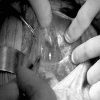Detection of sentinel lymph nodes in patients with early stage cervical cancer
- PMID: 17297260
- PMCID: PMC2693543
- DOI: 10.3346/jkms.2007.22.1.105
Detection of sentinel lymph nodes in patients with early stage cervical cancer
Abstract
The purpose of this study was to determine the feasibility of identifying the sentinel lymph nodes (SNs) as well as to evaluate factors that might influence the SN detection rate in patients with cervical cancer of the uterus. Eighty nine patients underwent intracervical injection of 1% isosulfan blue dye at the time of planned radical hysterectomy and lymphadenectomy between January 2003 and December 2003. With the visual detection of lymph nodes that stained blue, SNs were identified and removed separately. Then all patients underwent complete pelvic lymph node dissection and/or para-aortic lymph node dissection. SNs were identified in 51 of 89 (57.3%) patients. The most common site for SN detection was the external iliac area. Metastatic nodes were detected in 21 of 89 (23.5%) patients. One false negative SN was obtained. Successful SN detection was more likely in patients younger than 50 yr (p=0.02) and with a history of preoperative conization (p=0.05). However, stage, histological type, surgical procedure and neoadjuvant chemotherapy showed no significant difference for SN detection rate. Therefore, the identification of SNs with isosulfan blue dye is feasible and safe. The SN detection rate was high in patients younger than 50 yr or with a history of preoperative conization.
Figures
Similar articles
-
Contribution of the sentinel node procedure to tailoring the radicality of hysterectomy for cervical cancer.Gynecol Oncol. 2007 Jul;106(1):251-6. doi: 10.1016/j.ygyno.2007.03.034. Epub 2007 May 8. Gynecol Oncol. 2007. PMID: 17490734
-
Laparoscopic sentinel node biopsy in cervical cancer using a combined detection: 5-years experience.Ann Surg Oncol. 2007 Aug;14(8):2392-9. doi: 10.1245/s10434-007-9424-6. Epub 2007 May 16. Ann Surg Oncol. 2007. PMID: 17505858
-
Laparoscopic detection of sentinel lymph nodes using blue dye in women with cervical and endometrial cancer.Med Sci Monit. 2004 Oct;10(10):CR587-91. Epub 2004 Sep 23. Med Sci Monit. 2004. PMID: 15448599
-
Sentinel lymph node as a new marker for therapeutic planning in breast cancer patients.J Surg Oncol. 2004 Mar;85(3):102-11. doi: 10.1002/jso.20022. J Surg Oncol. 2004. PMID: 14991881 Review.
-
[Usefulness of the sentinel node in the treatment and staging of initial cervix cancer].Rev Esp Med Nucl. 2004 Jul-Aug;23(4):253-8. doi: 10.1016/s0212-6982(04)72295-8. Rev Esp Med Nucl. 2004. PMID: 15207209 Review. Spanish.
Cited by
-
The EANM clinical and technical guidelines for lymphoscintigraphy and sentinel node localization in gynaecological cancers.Eur J Nucl Med Mol Imaging. 2014 Jul;41(7):1463-77. doi: 10.1007/s00259-014-2732-8. Epub 2014 Mar 8. Eur J Nucl Med Mol Imaging. 2014. PMID: 24609929
-
Predictors of Non-Sentinel Lymph Node Metastasis in Patients with Positive Sentinel Lymph Node in Early-Stage Cervical Cancer: A SENTICOL GROUP Study.Cancers (Basel). 2023 Sep 26;15(19):4737. doi: 10.3390/cancers15194737. Cancers (Basel). 2023. PMID: 37835431 Free PMC article.
-
Sentinel-lymph-node procedures in early stage cervical cancer: a systematic review and meta-analysis.Med Oncol. 2015 Jan;32(1):385. doi: 10.1007/s12032-014-0385-x. Epub 2014 Nov 28. Med Oncol. 2015. PMID: 25429838 Free PMC article.
-
Sentinel lymph node biopsy as guidance for radical trachelectomy in young patients with early stage cervical cancer.BMC Cancer. 2011 May 2;11:157. doi: 10.1186/1471-2407-11-157. BMC Cancer. 2011. PMID: 21529381 Free PMC article.
-
Sentinel Lymph Node Biopsy Is Feasible in Cervical Cancer Laparoscopic Surgery: A Single-Center Retrospective Cohort Study.J Oncol. 2021 Apr 16;2021:5510623. doi: 10.1155/2021/5510623. eCollection 2021. J Oncol. 2021. PMID: 33953743 Free PMC article.
References
-
- Sakuragi N, Satoh C, Takeda N, Hareyama H, Takeda M, Yamamoto R, Fujimoto T, Oikawa M, Fujino T, Fujimoto S. Incidence and distribution pattern of pelvic and paraaortic lymph node metastasis in patients with stages IB, IIA, and IIB cervical carcinoma treated with radical hysterectomy. Cancer. 1999;85:1547–1554. - PubMed
-
- Benedetti-Panici P, Maneschi F, D'Andrea G, Cutillo G, Rabitti C, Congiu M, Coronetta F, Capelli A. Early cervical carcinoma: the natural history of lymph node involvement redefined on the basis of thorough parametrectomy and giant section study. Cancer. 2000;88:2267–2274. - PubMed
-
- Park CT, Seong SJ, Kim TJ, Lim KT, Chung HW, Park IS, Shim JU, Lee KH. Clinico-pathologic profiles and 5-year survival rate of 2209 patients with invasive cancer of the uterine cervix. Korean J Obstet Gynecol. 2003;46:1404–1410.
-
- Beyersdorff D, Bahnsen J, Frischbier HJ. Nodal involvement in cancer of the uterine cervix: value of lymphography and MRI. Eur J Gynaecol Oncol. 1995;16:274–277. - PubMed
-
- Morton DL, Wen DR, Wong JH, Economou JS, Cagle LA, Storm FK. Technical details of intraoperative lymphatic mapping for early stage melanoma. Arch Surg. 1992;127:392–399. - PubMed


